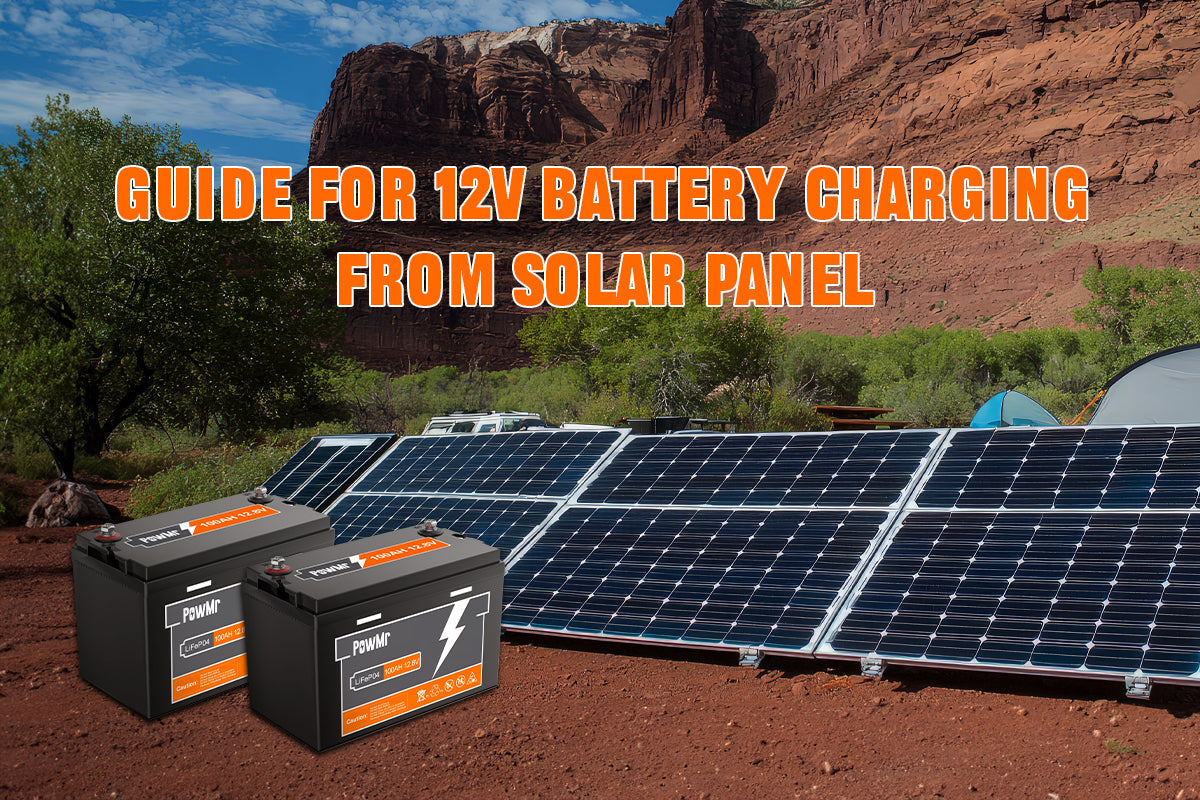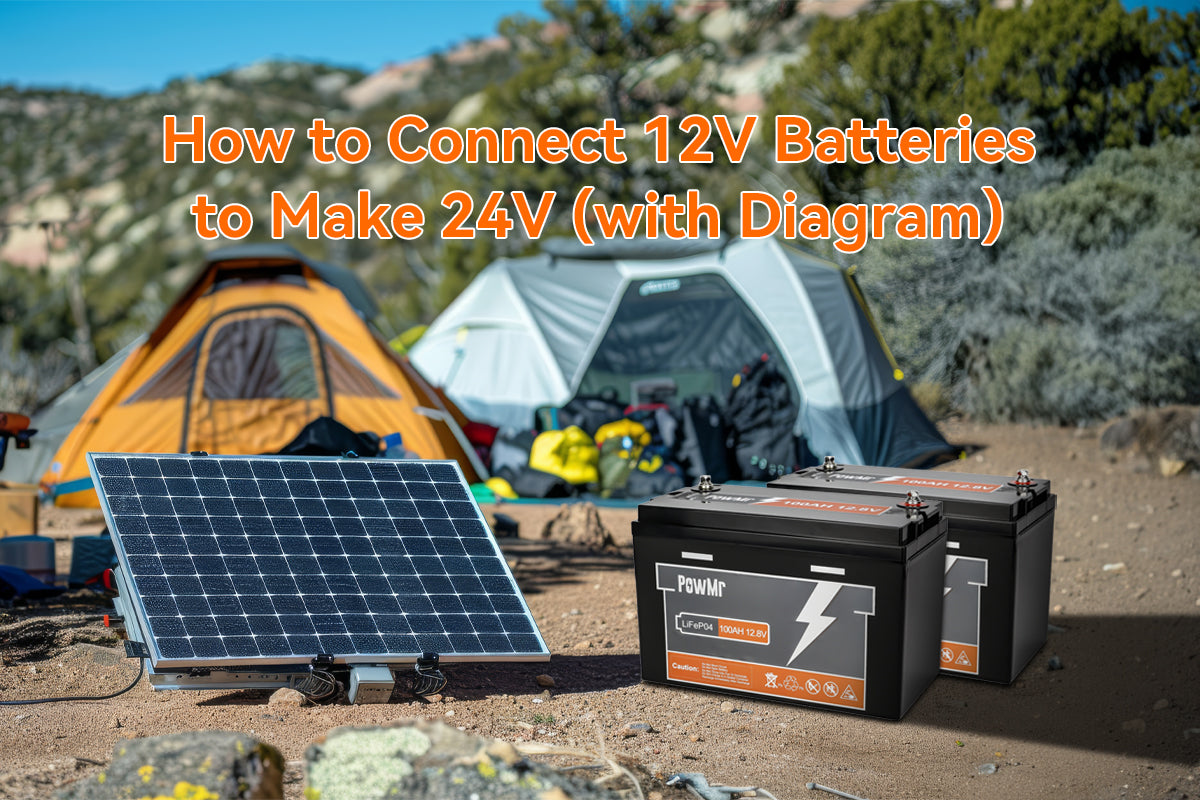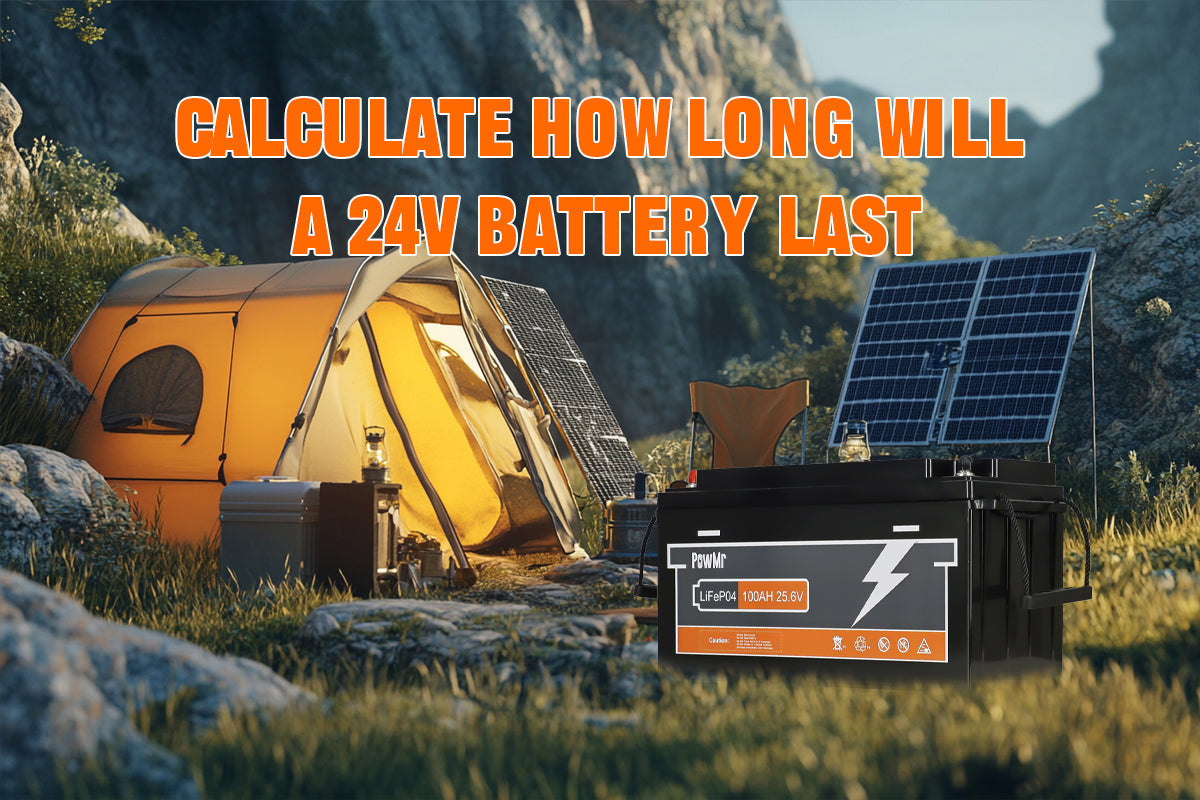ไม่ว่าคุณจะตั้งค่าระบบ RV ชาร์จแบตเตอรี่สำรอง หรือจ่ายไฟให้กับบ้านนอกกริดในสถานที่ห่างไกล คู่มือนี้จะพาคุณไปเรียนรู้ทุกสิ่งที่คุณต้องรู้เกี่ยวกับ การชาร์จแบตเตอรี่ 12V โดยใช้แผงโซลาร์เซลล์.
เราจะพูดถึงวิธีการกำหนดขนาดแผงโซลาร์เซลล์ที่เหมาะสม คำนวณจำนวนแผงที่ต้องการ เลือกตัวควบคุมการชาร์จพลังงานแสงอาทิตย์ และสุดท้าย เชื่อมต่อทุกอย่างเพื่อให้กระบวนการชาร์จเป็นไปอย่างราบรื่นและมีประสิทธิภาพ
- ขั้นตอนที่ 1 - กำหนดขนาดแผงโซลาร์เซลล์ที่ใช้ชาร์จแบตเตอรี่ 12 โวลต์
- ขั้นตอนที่ 2 - คำนวณจำนวนแผงโซลาร์เซลล์ที่ต้องใช้ในการชาร์จแบตเตอรี่ 12 โวลต์
- ขั้นตอนที่ 3 - เลือกตัวควบคุมการชาร์จพลังงานแสงอาทิตย์สำหรับแบตเตอรี่ 12V
- ขั้นตอนที่ 4 - เชื่อมต่อแบตเตอรี่กับตัวควบคุมการชาร์จพลังงานแสงอาทิตย์
- ขั้นตอนที่ 5 - ตั้งค่าพารามิเตอร์การชาร์จแบตเตอรี่ 12v
ขั้นตอนที่ 1 - กำหนดขนาดแผงโซลาร์เซลล์ที่ใช้ชาร์จแบตเตอรี่ 12 โวลต์
ขั้นตอนแรกในการชาร์จแบตเตอรี่ 12V ของคุณจากแผงโซลาร์เซลล์คือการกำหนดขนาดของแผงตามกำลังวัตต์ที่ต้องการ ซึ่งขึ้นอยู่กับสองปัจจัย: ความจุของแบตเตอรี่ และ ความเร็วที่คุณต้องการให้กระบวนการชาร์จเป็นไป.
ความจุของแบตเตอรี่ 12V คืออะไร?
เมื่อชาร์จแบตเตอรี่ด้วยแผงโซลาร์เซลล์ ความจุของแบตเตอรี่ ซึ่งมักวัดเป็นแอมป์-ชั่วโมง (Ah) จะบอกว่าแบตเตอรี่สามารถจ่ายพลังงานได้นานแค่ไหนและสามารถดูดซับพลังงานแสงอาทิตย์ได้มากเพียงใด.
ในการคำนวณวัตต์-ชั่วโมง (Wh) ที่ต้องการสำหรับการชาร์จเต็ม ให้คูณความจุ Ah ของแบตเตอรี่ด้วยแรงดันไฟฟ้าชื่อ (12V):
- แอมป์-ชั่วโมง × แรงดันไฟฟ้า = วัตต์-ชั่วโมง
ตัวอย่างเช่น แบตเตอรี่ 12V 100Ah ต้องการพลังงานประมาณ 1200 วัตต์-ชั่วโมงสำหรับการชาร์จเต็ม (12V × 100Ah = 1200Wh) ซึ่งให้การประมาณการที่ชัดเจนเกี่ยวกับพลังงานที่จำเป็นในการชาร์จแบตเตอรี่ให้เต็ม.
คุณหวังว่าจะชาร์จแบตเตอรี่ 12V ได้เร็วแค่ไหน
เพื่อให้บรรลุเป้าหมายการชาร์จแบตเตอรี่ของคุณ Wh แสดงถึงพลังงานรวมที่จำเป็นสำหรับการชาร์จ ในขณะที่ W แสดงถึงกำลังไฟฟ้าต่อชั่วโมงของแผงโซลาร์เซลล์ คุณสามารถ แปลง Wh เป็น W ได้โดยการหาร Wh ที่ต้องการด้วย เวลาชาร์จที่คาดหวัง ซึ่งจะให้กำลังวัตต์ที่จำเป็นสำหรับขนาดแผงโซลาร์เซลล์
- วัตต์ = วัตต์-ชั่วโมง / ชั่วโมง
ตัวอย่างเช่น หากคุณต้องการชาร์จแบตเตอรี่ 12V 100Ah ใน 3 ชั่วโมง คุณจะต้องใช้ แผงโซลาร์เซลล์ 400W (1200Wh ÷ 3h = 400W) หากคุณต้องการการชาร์จที่ช้าลงใน 6 ชั่วโมง แผงโซลาร์เซลล์ 200W จะเพียงพอ.
โปรดจำไว้ว่าการคำนวณเหล่านี้เป็นเพียงสมมุติฐาน; เวลาชาร์จ แบตเตอรี่ ที่แท้จริงอาจได้รับผลกระทบจากปัจจัยต่างๆ เช่น ชั่วโมงแสงแดดสูงสุด และ กระแสชาร์จ ดังนั้นอาจต้องมีการปรับเปลี่ยนตามสถานการณ์เฉพาะของคุณ.
ขั้นตอนที่ 2 - คำนวณจำนวนแผงโซลาร์เซลล์ที่ต้องใช้ในการชาร์จแบตเตอรี่ 12 โวลต์
เมื่อคุณได้กำหนดขนาดแผงโซลาร์เซลล์ที่เหมาะสมสำหรับการชาร์จแบตเตอรี่ 12V แล้ว ขั้นตอนถัดไปคือการคำนวณจำนวนแผงโซลาร์เซลล์ที่คุณต้องการ สำหรับการคำนวณจำนวนแผงโซลาร์เซลล์
- จำนวนแผง = กำลังวัตต์รวมที่ต้องการ / กำลังวัตต์ต่อแผง
ตัวอย่างเช่น หากคุณตัดสินใจว่าคุณต้องการพลังงานแสงอาทิตย์ 400W เพื่อชาร์จแบตเตอรี่ 12v 100ah ภายใน 3 ชั่วโมง และคุณกำลังใช้ แผงโซลาร์เซลล์ 100W คุณจะต้องใช้แผง 4 แผงเพื่อให้ตรงตามความต้องการนั้น.
หากคุณกำลังใช้ขนาดแผงที่แตกต่างกัน ให้ปรับจำนวนให้เหมาะสม นอกจากนี้ยังต้องคำนึงถึงพื้นที่ติดตั้งที่คุณมีและปริมาณแสงแดดโดยตรงที่แผงของคุณจะได้รับ สำหรับข้อมูลเพิ่มเติม โปรดดูที่ คู่มือการคำนวณจำนวนแผงโซลาร์เซลล์ที่คุณต้องการ.
ขั้นตอนที่ 3 - เลือกตัวควบคุมการชาร์จพลังงานแสงอาทิตย์สำหรับแบตเตอรี่ 12V
ตัวควบคุมการชาร์จพลังงานแสงอาทิตย์ เป็นสิ่งจำเป็นสำหรับการชาร์จแบตเตอรี่ด้วยแผงโซลาร์เซลล์ มันควบคุมแรงดันไฟฟ้าและกระแสไฟฟ้าที่ไหลจากแผงไปยังแบตเตอรี่ เมื่อ เลือกตัวควบคุมการชาร์จ ให้พิจารณาประเภทแบตเตอรี่ ความเข้ากันได้ของแรงดันไฟฟ้า และกระแสไฟฟ้าของแผงโซลาร์เซลล์ของคุณ.
-
ประเภทแบตเตอรี่:
ประเภทของแบตเตอรี่ เช่น แบตเตอรี่ตะกั่ว-กรด, AGM หรือ ลิเธียมไอออน มีความต้องการการชาร์จที่แตกต่างกัน ดังนั้นจึงควรเลือกตัวควบคุมที่เหมาะสมกับแบตเตอรี่ของคุณ. -
ความเข้ากันได้ของแรงดันไฟฟ้า:
"ตัวควบคุมการชาร์จของคุณต้องตรงกับแรงดันไฟฟ้าของระบบแบตเตอรี่ของคุณ ในกรณีนี้ แบตเตอรี่ 12V ต้องการตัวควบคุมที่เข้ากันได้กับระบบ 12V ดังนั้นโปรดเลือกตัวที่เหมาะสมกับการติดตั้งของคุณ"
เคล็ดลับ: ฉันสามารถชาร์จแบตเตอรี่ 12V ด้วยที่ชาร์จ 24V ได้หรือไม่?
ทางเทคนิคแล้ว คุณ ไม่สามารถ ชาร์จแบตเตอรี่ 12V โดยตรงด้วยเครื่องชาร์จ 24V ได้ เนื่องจากการตั้งค่าความดันไฟฟ้าสำหรับระบบแบตเตอรี่ที่มีแรงดันไฟฟ้าต่างกันนั้นแตกต่างกัน การใช้เครื่องชาร์จ 24V กับแบตเตอรี่ 12V อาจทำให้แบตเตอรี่เสียหาย แต่สามารถชาร์จแบตเตอรี่ 12V ด้วยเครื่องชาร์จ 24V ได้ โดย เชื่อมต่อแบตเตอรี่ 12V เพื่อสร้างการตั้งค่า 24V.
คำแนะนำ :
นอกจากนี้ คุณสามารถเลือกตัวควบคุมการชาร์จพลังงานแสงอาทิตย์ที่รองรับหลายแรงดันไฟฟ้า ตัวอย่างเช่น ตัวควบคุมการชาร์จพลังงานแสงอาทิตย์ PowMr ส่วนใหญ่ รองรับ ระบบ 12V, 24V, 36V และ 48V ซึ่งให้ความยืดหยุ่นในการปรับแต่งการกำหนดค่าของแรงดันไฟฟ้าของแผงโซลาร์เซลล์และแบตเตอรี่.
-
ขีดจำกัดกำลังวัตต์และแรงดันไฟฟ้า:
"ตัวควบคุมการชาร์จพลังงานแสงอาทิตย์มีข้อจำกัดด้านพลังงานและแรงดันไฟฟ้า กำลังวัตต์รวมของแผงโซลาร์เซลล์ของคุณต้องไม่เกินการจัดอันดับสูงสุดของตัวควบคุม และแรงดันไฟฟ้าต้องอยู่ในช่วงการทำงานของตัวควบคุม สำหรับคำแนะนำเพิ่มเติม โปรดดูที่ คู่มือการเลือกตัวควบคุมการชาร์จพลังงานแสงอาทิตย์". -
ความเข้ากันได้ของกระแสไฟฟ้า:
ในการเลือกตัวควบคุมที่ถูกต้อง, ให้แบ่งกำลังวัตต์ของแผงโดยแรงดันไฟฟ้าของแบตเตอรี่. ตัวอย่างเช่น แผง 400W ที่ชาร์จแบตเตอรี่ 12V ต้องการตัวควบคุม 33A (400W ÷ 12V = 33.3A). การจัดอันดับกระแสของตัวควบคุมต้องเท่ากับหรือต้องมากกว่ากระแสสูงสุดของแผงเพื่อป้องกันการโอเวอร์โหลด. แนะนำให้เลือกตัวควบคุมที่มี ความจุพิเศษ 20-30% เพื่อความปลอดภัยที่เพิ่มขึ้น.
นอกจากนี้ แอมป์การชาร์จยังมีผลต่อเวลาการชาร์จของแบตเตอรี่ ดังนั้นโปรดพิจารณาเรื่องนี้ด้วย
ขั้นตอนที่ 4 - เชื่อมต่อแบตเตอรี่กับตัวควบคุมการชาร์จพลังงานแสงอาทิตย์
เมื่อคุณติดตั้งแผงโซลาร์เซลล์และตัวควบคุมการชาร์จเรียบร้อยแล้ว ขั้นตอนถัดไปคือการเชื่อมต่อแบตเตอรี่กับตัวควบคุมการชาร์จ ปฏิบัติตามขั้นตอนเหล่านี้เพื่อการเชื่อมต่อที่ปลอดภัยและเชื่อถือได้:
1. เชื่อมต่อแบตเตอรี่ก่อน
เชื่อมต่อแบตเตอรี่กับตัวควบคุมการชาร์จ ก่อน เชื่อมต่อแผงโซลาร์เซลล์เสมอ นี่จะช่วยให้ตัวควบคุมการชาร์จมีแรงดันอ้างอิงที่เสถียรจากแบตเตอรี่
2. ใช้การเดินสายที่เหมาะสม
ใช้สายไฟที่มีขนาดเหมาะสมสำหรับการเชื่อมต่อเพื่อรองรับกระแสไฟโดยไม่ให้เกิดการลดแรงดันไฟฟ้าอย่างมีนัยสำคัญ สำหรับระบบ 12V ส่วนใหญ่ สายไฟขนาด 10 หรือ 12 AWG จะเหมาะสม
3. ตรวจสอบขั้ว
ตรวจสอบให้แน่ใจว่าคุณเชื่อมต่อขั้วบวกและขั้วลบอย่างถูกต้องเพื่อหลีกเลี่ยงความเสียหายต่อระบบ.
4. เชื่อมต่อแผงโซลาร์เซลล์
เมื่อเชื่อมต่อแบตเตอรี่แล้ว คุณสามารถเชื่อมต่อแผงโซลาร์เซลล์กับตัวควบคุมการชาร์จได้ ตัวควบคุมการชาร์จจะควบคุมพลังงานที่ไหลเข้าสู่แบตเตอรี่อัตโนมัติ
ขั้นตอนที่ 5 - ตั้งค่าพารามิเตอร์การชาร์จแบตเตอรี่ 12v
สุดท้าย ให้ตั้งค่าพารามิเตอร์การชาร์จบนตัวควบคุมการชาร์จสำหรับแบตเตอรี่ 12V ของคุณ การตั้งค่าที่ถูกต้องจะช่วยให้แบตเตอรี่ชาร์จเต็มโดยไม่เกิดการชาร์จเกิน ซึ่งอาจลดอายุการใช้งานของแบตเตอรี่ได้.
ดังนั้น ตาม พารามิเตอร์การชาร์จหลัก ของผู้ผลิตแบตเตอรี่ เช่น แรงดันไฟฟ้าขณะชาร์จเต็ม แรงดันไฟฟ้าขณะลอยตัว แรงดันไฟฟ้าที่เกิน แบตเตอรี่ชาร์จเกิน และการปล่อยเกิน เราได้จัดเตรียมสิ่งต่อไปนี้: แผนภูมิแรงดันไฟฟ้าแบตเตอรี่และคู่มือ SOC รวมถึงคู่มือการชาร์จแบตเตอรี่ LiFePO4.
แหล่งข้อมูลเพิ่มเติม
เพื่อความเข้าใจที่ดีขึ้นและแนวทางปฏิบัติที่ชัดเจน โปรดดูแหล่งข้อมูลต่อไปนี้:
- แผนภูมิแรงดันแบตเตอรี่และคู่มือ SOC:นี่ให้ข้อมูลเชิงลึกเกี่ยวกับสถานะการชาร์จ (SOC) สำหรับประเภทแบตเตอรี่ต่างๆ ช่วยให้คุณเข้าใจระดับแรงดันในระหว่างขั้นตอนการชาร์จที่แตกต่างกัน.
- คู่มือการชาร์จแบตเตอรี่ LiFePO4:หากคุณกำลังใช้แบตเตอรี่ลิเธียม คู่มือนี้จะให้คำแนะนำเฉพาะที่เหมาะกับความต้องการของพวกเขา.



